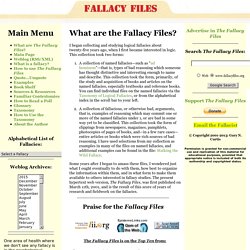

Www.udel.edu/CIS/106/iaydin/07F/misc/firstJob.pdf. A Visual Guide to Cognitive Bias. You’re biased.

I’m biased. We’re all biased when it comes to thinking, remembering, being social, and making decisions. Understanding the different cognitive biases we have can help us design and interpret experiments, interact with each other, and make healthy, rational choices. Cognitive Biases - A Visual Study Guide. LEO: Logic. When you attempt to employ logic to support claims in your papers, your reasoning is sometimes weakened because you are presenting fallacious arguments.
It is important for you to be able to identify and eliminate fallacies in your writing. This handout will explain and give examples of typical fallacies as divided into five major categories: The argumentation methods comprising these five categories can be used as rhetorical devices, but they must not be confused with logical thinking. Tutors can help their students to make such a distinction. Quite often, writers appeal to their audiences' feelings to attract attention to and elicit agreement with their ideas. Appeal to Force: The writer threatens the audience, explicitly or implicitly, with negative consequences if the claim is not believed. If you do not believe in God, you will go to hell.Appeal to Pity: The writer begs for the approval of the claim; the audience may agree because they feel sorry for the arguer. Sources Pitt, Jack. What are the Fallacy Files? I began collecting and studying logical fallacies about twenty-five years ago, when I first became interested in logic.

This collection took two forms: A collection of named fallacies—such as "ad hominem"—that is, types of bad reasoning which someone has thought distinctive and interesting enough to name and describe. This collection took the form, primarily, of the study and acquisition of books and articles on the named fallacies, especially textbooks and reference books. You can find individual files on the named fallacies via the Taxonomy of Logical Fallacies, or from the alphabetical index in the scroll bar to your left.
A collection of fallacious, or otherwise bad, arguments, that is, examples of reasoning which may commit one or more of the named fallacies under 1, or are bad in some way yet to be classified. Praise for the Fallacy Files Contribute to the Fallacy Files You can contribute fallacies and examples to the files by sending them to me. Email Policy Advertisement Policy. Critical Thinking On The Web. Top Ten Argument Mapping Tutorials.

Six online tutorials in argument mapping, a core requirement for advanced critical thinking.The Skeptic's Dictionary - over 400 definitions and essays. The Fallacy Files by Gary Curtis. Best website on fallacies. Butterflies and Wheels. What is critical thinking? Nobody said it better than Francis Bacon, back in 1605: For myself, I found that I was fitted for nothing so well as for the study of Truth; as having a mind nimble and versatile enough to catch the resemblances of things … and at the same time steady enough to fix and distinguish their subtler differences; as being gifted by nature with desire to seek, patience to doubt, fondness to meditate, slowness to assert, readiness to consider, carefulness to dispose and set in order; and as being a man that neither affects what is new nor admires what is old, and that hates every kind of imposture.
Home. ENC3312.pdf (application/pdf Object) Home - Insight Assessment. A Taxonomy of Reflection: Critical Thinking For Students, Teachers, and Principals (Part I) My approach to staff development (and teaching) borrows from the thinking of Donald Finkel who believed that teaching should be thought of as "providing experience, provoking reflection.

" He goes on to write, ... to reflectively experience is to make connections within the details of the work of the problem, to see it through the lens of abstraction or theory, to generate one's own questions about it, to take more active and conscious control over understanding. ~ From Teaching With Your Mouth Shut Over the last few years I've led many teachers and administrators on classroom walkthroughs designed to foster a collegial conversation about teaching and learning. The walkthroughs served as roving Socratic seminars and a catalyst for reflection. But reflection can be a challenging endeavor. In an effort to help schools become more reflective learning environments, I've developed this "Taxonomy of Reflection. " - modeled on Bloom's approach. 1. See my Prezi tour of the Taxonomy.